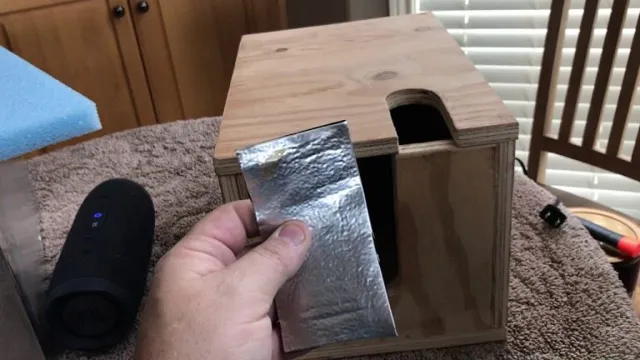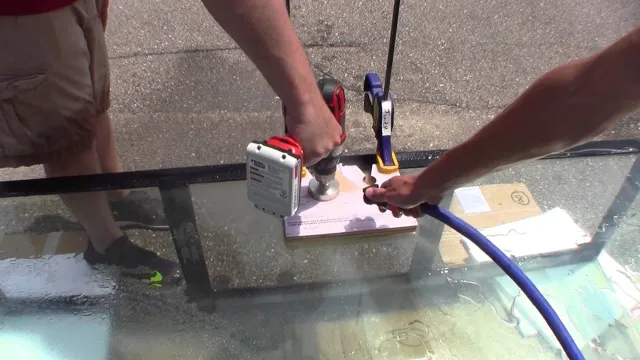As an aquarium owner, there’s nothing more frustrating than hearing the constant hum of your aquarium pump. Not only is the noise disruptive to your peaceful space, but it can be stressful for your fish and other aquatic creatures as well. Luckily, creating a soundproof box for your aquarium pump is an easy and affordable solution.
By following a few simple steps, you can minimize the noise coming from your aquarium and improve the overall environment for your aquatic pets. Let’s dive in and explore how to create a soundproof box for your aquarium pump.
Why You Need a Soundproof Box
Are you tired of the loud noises coming from your aquarium pump disturbing the peace in your home? One solution to this problem is to make a soundproof box for your aquarium pump. Not only will it reduce the noise level significantly, it will also prevent vibrations from reaching other parts of your home. To make a soundproof box, you will need soundproof materials such as acoustic foam or mass loaded vinyl, a wooden box, and tools such as a saw and a drill.
First, measure the dimensions of your aquarium pump and cut out a hole in the wooden box to fit it snugly. Then, line the inside of the box with the soundproof materials, ensuring that there are no gaps or openings for sound to escape. Finally, cover the hole with a soundproof material and install the aquarium pump inside the box.
Voila! Your DIY soundproof box is ready to reduce noise levels in your home and give your aquarium pump a quieter operation. Enjoy a peaceful environment without sacrificing the beauty of your fish tank.
Reducing Noise Levels
Reducing Noise Levels If you’re tired of hearing the constant hum of your equipment, a soundproof box may be exactly what you need. These boxes are specially designed to reduce noise levels and create a more peaceful environment. They’re perfect for recording studios, offices, and homes that are located near busy streets or loud construction sites.
When considering a soundproof box, it’s important to choose one that is made from high-quality materials. Cheaply constructed boxes may not be effective at reducing noise levels, and they may even leak sound. With a soundproof box, you can enjoy a quieter environment that is more conducive to your work or relaxation.

Improving Aquarium Aesthetics
If you’re an aquarium enthusiast, then you know that the aesthetic appeal of your tank is just as important as the health of the fish residing in it. One element that can have a big impact on the overall appearance of your aquarium is the sound of the water and the equipment used to filter and maintain it. That’s why investing in a soundproof box is a great idea for any serious aquarist.
Not only will it make your aquarium much quieter, but it also helps to reduce the amount of vibration produced by your filters, pumps, and heaters. And the best part is that a soundproof box is easy to install and won’t break the bank. So why not give your aquarium the gift of peace and quiet with a soundproof box today?
Preventing Damage to Your Pump
As a pump owner, it’s essential to ensure that your pump is always functioning optimally to prevent damage. One way to do this is by investing in a soundproof box. The box provides an extra layer of protection to the pump, shielding it from external factors that could potentially damage it.
For instance, the soundproof box significantly reduces noise levels, which is beneficial in preventing hearing loss or other related health problems. Additionally, the box ensures that the pump is protected from adverse weather conditions, including rain or direct sunlight. It also keeps dust, debris, and other physical factors away from the pump, guaranteeing long-term functionality.
Besides, a soundproof box has improved ventilation that stabilizes the pump’s temperature, preventing overheating and subsequent damage. Keep your pump safe from damage by investing in a soundproof box – it’s a wise investment that helps prolong your pump’s lifespan.
Materials and Tools You Will Need
If you’re tired of the constant noise from your aquarium pump, creating a soundproof box can be a game changer. To start, you’ll need a few materials and tools. First, you’ll need a wooden box or crate that’s large enough to accommodate your pump, with ample space around it.
You’ll also need soundproofing materials such as acoustic foam or mass loaded vinyl to line the interior walls. Additionally, you’ll need a saw, drill, screws, hinges, and a latch to assemble the box. Other helpful tools include a staple gun, utility knife, and a ruler or measuring tape.
With these materials and tools on hand, you’re ready to create your own soundproof box for your aquarium pump and enjoy a quieter home environment.
Soundproof Insulation
Soundproof insulation is a must-have if you want to reduce noise levels in your home or office. To get started with this project, there are several materials and tools that you will need. First, you will need high-density soundproof insulation.
This is typically made from fiberglass, rock wool, or cellulose and is available in rolls or panels. You will also need a utility knife or saw to cut the insulation to fit your space, as well as a staple gun or adhesive to secure it in place. Additionally, you will need acoustic caulking to fill any gaps or cracks in your walls or windows that could let noise in.
For a finishing touch, you may want to consider adding acoustic panels or curtains to absorb any remaining soundwaves. With the right materials and tools, soundproofing your space can be a straightforward and effective way to create a quieter and more peaceful environment. (See Also: How to Go From Saltwater to Freshwater Aquarium: Easy Guide for Beginners)
Sealant
Sealant When it comes to applying sealant, there are several materials and tools you will need for the job. First and foremost, you will require the sealant itself, which can come in various materials such as silicone, polyurethane or acrylic. Each type of sealant has its own unique properties, so it’s important to determine which one will work best for your specific project.
You will also need a caulking gun, which will help you apply the sealant in a controlled manner. Other tools you may need include a putty knife, surface cleaner, and painter’s tape. It’s important to ensure that the surface you’ll be applying the sealant to is clean and dry to ensure the best adherence and longevity.
Finally, be sure to follow the manufacturer’s instructions carefully to ensure you achieve the best results. By using the right materials and tools, you can apply sealant correctly and ensure that your project is both functional and aesthetically pleasing.
Acrylic or Plexiglass Sheet
If you’re looking to work with acrylic or plexiglass sheet, you’ll need a few key materials and tools to get started. First and foremost, you’ll need the sheet itself, which you can purchase online or at a craft or hardware store. You’ll also need a cutting tool, such as a jigsaw or circular saw, to cut the sheet down to size.
A heat gun or small torch may also come in handy for bending or shaping the sheet. Additionally, you’ll want to have sandpaper or a sanding block on hand to smooth out any rough edges after cutting. Finally, protective gear such as gloves and eye goggles are a must to ensure your safety while working with these materials.
By having all of these materials and tools on hand, you’ll be ready to tackle any acrylic or plexiglass project you have in mind.
Box Cutter or Jigsaw
When it comes to cutting materials such as wood or metal, various tools can be used. Box cutters and jigsaws are both commonly used tools, but which one is better? The answer is that it depends on the material you are cutting and the type of cut you need to make. For smaller, more precise cuts, a box cutter may be the better choice.
However, for larger, curved cuts, a jigsaw is likely to be the better option. Regardless of which tool you choose, there are a few materials and tools that you will need. For a box cutter, you will need the box cutter blade itself, as well as a good quality cutting surface.
A cutting mat or thick cardboard can work well as a surface. For a jigsaw, you will need the jigsaw itself, a blade suitable for the material you are cutting, and a stable work surface. Whether you choose a box cutter or a jigsaw, it is important to prioritize safety when using any cutting tool.
Always wear protective gear such as safety glasses or goggles, and keep fingers and other body parts away from the blade. With the right tools and precautions, you can achieve clean, precise cuts in no time.
Silicone Glue
One of the essential tools you need when working with silicone glue is a good quality silicone adhesive. You also need a clean workspace, preferably on top of a protective tablecloth or mat. Make sure to have a pair of gloves on hand to protect your skin from the adhesive, as well as a scraper or spatula for applying it to your chosen material.
A steady hand and patience are also necessary to ensure accurate application. It’s best to have the proper ventilation, as silicone glue often puts off strong fumes. Always have a damp cloth close by to clean up any excess glue, and a bottle of rubbing alcohol to remove any adhesive residue.
With the right materials and tools, you’ll be able to work confidently and create a seamless, strong bond.
Building Your Soundproof Box
If you have an aquarium pump that creates a lot of noise and vibrations, building a soundproof box is a great way to reduce the sound. Start by measuring the dimensions of your pump and purchasing a wooden box that is slightly larger than it. Use sound insulation foam to line the interior of the box, ensuring that all surfaces are covered.
Cut out holes for the inlet and outlet tubes and cover the holes with soundproofing fabric. Attach the pump to the inside of the box using screws or brackets, making sure it is secure and does not vibrate against the walls of the box. Finally, seal all gaps and seams with acoustic caulking to ensure any remaining noise is blocked.
With your new soundproof box in place, you can enjoy a more peaceful and relaxing aquarium environment.
Measure and Cut Acrylic Sheet
When it comes to building your soundproof box, one of the most crucial steps is measuring and cutting the acrylic sheet that you will be using. Acrylic sheet is a highly durable plastic material that is perfect for soundproofing due to its ability to absorb sound waves. To begin, you’ll need a measuring tape and a marker to measure and mark the dimensions of the acrylic sheet.
Once you have done this, you can use a fine-toothed saw to cut along the marked lines. Be sure to take your time and cut slowly and carefully to ensure that the edges of the sheet are smooth and even. It’s also a good idea to wear protective gear like gloves and goggles to protect yourself from flying debris. (See Also: How to Install Aqua Culture Aquarium Air Pump: A Comprehensive Guide)
Overall, measuring and cutting acrylic sheet might seem daunting at first, but with a little patience and attention to detail, you’ll be well on your way to creating a soundproof box that will provide you with a peaceful oasis no matter where you are.
Attach Acrylic Sheet Sides to Base with Silicone Glue
After constructing the base of your soundproof box, the next step is to attach the acrylic sheet sides using silicone glue. This will provide a sturdy and secure enclosure that will effectively block out unwanted noise. It’s essential to use the appropriate glue to ensure a strong and long-lasting bond.
Silicone glue is an excellent choice for securing the acrylic sheets as it is waterproof, heat resistant, and can withstand extreme weather conditions. When applying the glue, be sure to use a continuous bead around the perimeter of the base to prevent any gaps. After applying the silicone glue, gently press the acrylic sheets in place and leave them to dry for a few hours.
Once the glue has cured, the soundproof box will be ready to use, effectively blocking any noises emitted from its source. Remember, using high-quality materials and attention to detail will ensure the best results for your DIY soundproof box project.
Seal Corners with Sealant
When building your soundproof box, one important aspect to consider is sealing the corners with sealant. The use of sealant ensures that there are no gaps or cracks where sound can escape through. This is especially important as sound can easily escape through small openings.
When using sealant, it is essential to ensure that it is applied evenly and in sufficient amounts to seal all corners effectively. Additionally, consider using a caulk gun for easier application and precision. Sealant can also help to prevent dust or debris from entering the soundproof box through the corners.
Overall, sealing the corners with sealant is an important step in building a soundproof box to ensure maximum sound insulation.
Fit Insulation Inside Box
One crucial step in building your soundproof box is fitting insulation inside. Insulation is essential for dampening sound waves and preventing them from escaping the box. There are various types of insulation to choose from, such as fiberglass, foam, or acoustic panels.
Fiberglass insulation is a popular choice as it is easy to install and provides excellent sound absorption. However, make sure to wear protective gear such as gloves, goggles, and a mask when handling fiberglass insulation. Foam insulation is another option, and it is usually applied by spraying it into the box.
Acoustic panels are pricier but provide excellent sound insulation and are aesthetically pleasing. Ensure that the entire box is covered with insulation, including all sides, the top, and the bottom. Once you have fitted the insulation, seal any gaps or cracks with acoustic caulking or weatherstripping tape to ensure no sound waves escape.
In summary, insulation is a vital component of building your soundproof box, and choosing the right type can make a significant difference in sound isolation.
Fit Pump Inside Box and Seal with Sealant
When it comes to building a soundproof box, fitting a pump inside it can be a bit tricky. However, it’s crucial to ensure that your device is not only soundproof but also efficient. The first step is to ensure that the pump fits snugly inside the box.
You don’t want it to move around when it is running as that can cause noise. Once you have placed your pump inside the box, the next step is to seal it with the appropriate sealant. You can use special acoustic sealants that offer excellent soundproofing abilities, or you can use regular sealant.
However, make sure that the sealant you use is compatible with the materials used to build the box. By sealing every opening, cracking or gap in your box with the right sealant, you can achieve a near-perfect soundproof barrier. It’s worth noting that with such barriers, you can comfortably run your pump without worrying about noise leakage.
Overall, fitting a pump in a soundproof box shouldn’t be too difficult with the right tools and information.
Using Your Soundproof Box
If you’re looking to reduce the noise coming from your aquarium pump, a soundproof box can be a great solution. The process of making a soundproof box may seem daunting at first, but it’s actually quite simple. First, gather your materials: a soundproofing material such as acoustic foam, a wooden crate or box, a power drill, and screws.
Measure the dimensions of your pump and use a jigsaw to cut holes into the box for your pump’s inlet and outlet. Line the inside of the box with acoustic foam and seal any gaps with caulk or weather stripping. Finally, attach the pump to the box with screws and test the sound levels to ensure it’s working properly. (See Also: How to Give Away Old Aquarium: Tips and Tricks for Safe Disposal)
By following these steps, you can have a more peaceful and quieter aquarium environment for you and your aquatic friends.
Monitor Pump Performance and Check for Leaks
When operating your soundproof box, it’s important to monitor the performance of your pump and check for any leaks. This not only ensures the efficiency of your equipment but also helps to maintain a safe working environment. Regularly inspecting your pump and checking for any leaks will prevent any potential mishaps that can occur if left undetected.
Furthermore, monitoring your pump’s performance can help identify any potential issues before they become major problems. For instance, noticing a slight drop in pressure could indicate a clog or worn component that can be easily fixed before it causes more significant damage. Therefore, it’s crucial to be attentive while using your soundproof box to ensure that your pump is functioning correctly and safely.
Check Insulation Regularly for Wear and Tear
As an owner of a soundproof box, you know how important it is to ensure that your box is functioning properly. Regularly checking your insulation for wear and tear is crucial in maintaining the soundproofing of your box. Over time, insulation can break down and lose its effectiveness, allowing unwanted noise to leak through.
This can be a frustrating experience, particularly if you’re trying to create a quiet workspace or sleeping environment. By inspecting your insulation on a regular basis, you can catch any issues early on and take steps to remedy the situation before it becomes a bigger problem. So make it a habit to check your insulation regularly, and enjoy the peace and quiet that your soundproof box can provide.
Conclusion
In conclusion, with a little creativity and some basic materials, creating a soundproof box for your aquarium pump is a breeze. Say goodbye to noisy, intrusive pump sounds and hello to a tranquil, perfectly balanced aquatic environment. Just remember, when it comes to soundproofing, a little effort goes a long way in ensuring a peaceful coexistence between you, your fish, and your pump.
“
FAQs
Why is it important to make a soundproof box for aquarium pump?
Aquarium pumps can be noisy and disruptive to the peaceful environment of your home. A soundproof box can help to muffle the sound and create a more enjoyable experience for you and your fish.
What materials are needed to make a soundproof box for aquarium pump?
Some materials you may need include acoustic foam, wood, screws, acoustic sealant, and a saw.
What is the best type of foam to use for soundproofing?
Acoustic foam is the best type of foam to use for soundproofing. It is specifically designed to absorb sound waves and reduce echo.
How do you measure the size of the box needed for your aquarium pump?
Measure the length, height, and width of your aquarium pump, and add a few inches to each measurement for ventilation and ease of access.
Can a soundproof box be used for other noisy household items?
Yes, a soundproof box can be used for any household items that create excessive noise, such as air conditioners or generators.
How long does it take to make a soundproof box for an aquarium pump?
The time it takes to make a soundproof box depends on the size and complexity of the design. It can take anywhere from a few hours to a full day.
Are there any safety precautions to keep in mind when building a soundproof box?
It is important to wear protective gear when cutting and sawing wood, and to be cautious when handling screws and other sharp objects. Make sure to also use a sealant that is safe for aquariums to avoid any harm to your fish.







